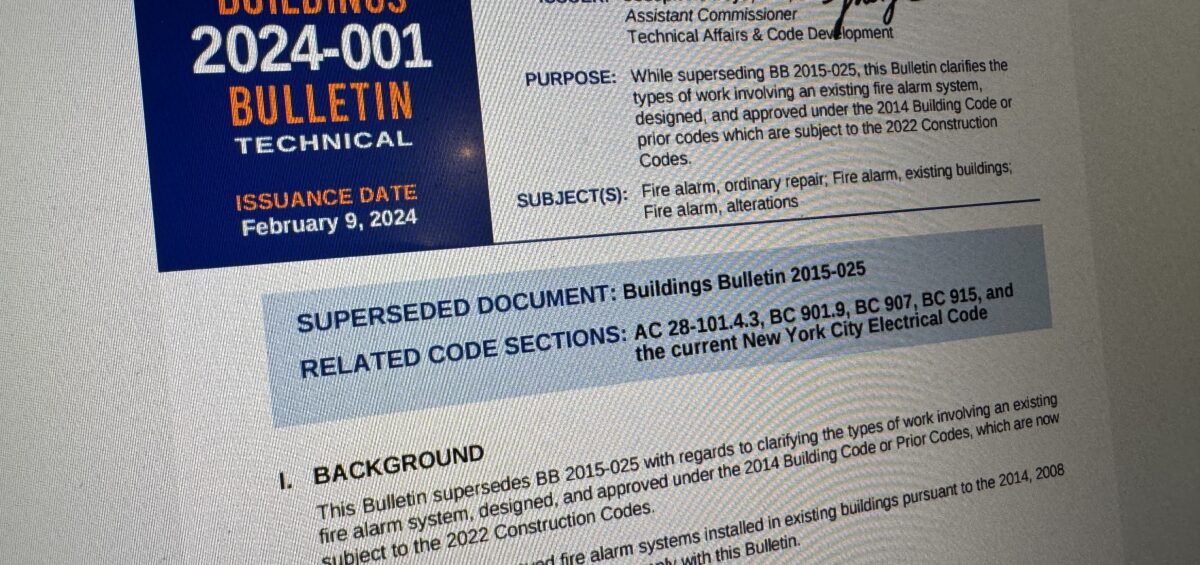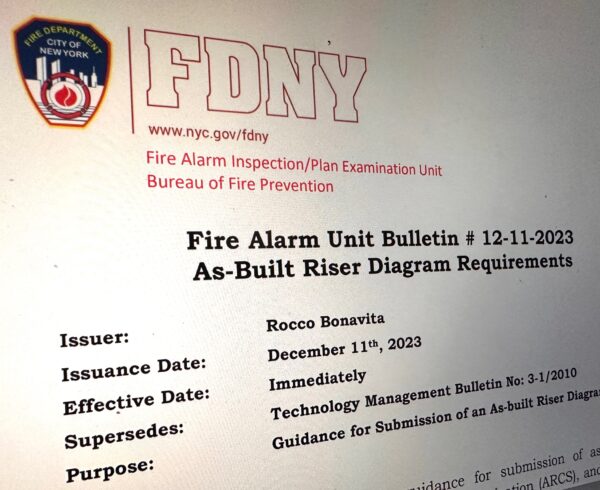The New York City Department of Buildings (DOB) recently issued Buildings Bulletin 2024-001 (or BB 2024-001) with an effective date of February 9, 2024. This bulletin supersedes the previous Buildings Bulletin 2015-025. The new bulletin clarifies the types of work involving an existing fire alarm system that was designed under the 2014 NYC Building Code or prior codes. This bulletin will continue to bridge the gap between the 2022 NYC Building Code (or, BC) and the forthcoming, not-yet-adopted NYC Existing Building Code. Until the Existing Building Code takes effect, the Building Code will continue to function as the applicable code for alterations of existing buildings in addition to its intended purpose as a code for new construction.
What’s the Same?
BB 2024-001 is structured in a similar manner to the prior bulletin it superseded. The bulletin contains sections describing work that constitutes a repair, alterations to an existing fire alarm system that cannot be considered a repair, and fire alarm system replacements. Here’s a few things that are the same or similar from the prior Bulletin:
- Alterations to an existing fire alarm system do not additionally require the installation of an Auxiliary Radio Communication System (or ARCS) unless the value of the alteration enacts the requirements of BC Section 901.9.4, the alteration creates a high-rise building or large area building where ARCS would be required for comparable new construction, or when the alteration results in a change of dominant occupancy or use to a high-rise or large area building.
- Full fire alarm system replacement in a building that would otherwise require the installation of ARCS will still require such an ARCS to be installed. Spoiler alert for future Sparc Notes – FDNY is undergoing an internal process to make significant changes to the ARCS design criteria and these are anticipated to be released in Q2 of 2024!
- A fire alarm control panel can be replaced provided that plans for an alteration have been filed with and approved by the New York City Fire Department (FDNY).
- A system technology upgrade only applies for existing systems that have both a distributed control unit (such as a Data Gathering Panel) AND a fire alarm control panel/Fire Command Station/etc. Existing fire alarm systems that have only one fire alarm control unit and do not have distributed control units as part of their system architecture are modified under Section III.A of the Bulletin, but not under Section III.C of the Bulletin!
What’s New?
For starters, the numbering! By adding Section I for background to the new BB, all of the subsequent sections were renumbered. For example, what was Section II in the prior bulletin about alterations that do not constitute a repair is now Section III.
Here’s a brief list of some of the other key changes to the new Bulletin:
- Clarifications to the System Technology Upgrade work category under the Alterations section of the bulletin (Section III.C) were added. The first clarification is on the pathway survivability requirements for these upgrades. Wiring for the riser portion of the system technology upgrade shall comply fully with the pathway survivability requirements of NFPA 72, 2016 edition, as amended by Appendix Q of the BC. Hint – check Section 24.3.13 of NFPA 72 to refresh on those requirements.
- Also under III.C, language was added to further confirm that it was permissible and remains permissible as part of a system technology upgrade to replace initiating devices and replace notification appliances without requiring a separate filing and without pushing a project into the Section IV Replacement category. This is significant as it reinforces that it is permissible to change system manufacturers as part of a system technology upgrade project, provided that some portion of the existing system is being re-used as part of the planned upgrade.
- Continuing with III.C, a new list item was added that indicates one-way voice communication must be installed in buildings that exceed 125 feet measured from the lowest level of Fire Department vehicle access to the walking surface of the highest occupied floor. This change clarifies that it is no longer acceptable to upgrade a non-voice system (e.g. a Temporal 3 system) in certain high-rise buildings if the existing fire alarm system does not have one-way voice communication capability. The goal of this provision is to phase out those existing, high-rise buildings that have approved fire alarm systems without voice communication.
Take a look at our fire alarm design and fire alarm consulting services for how we can help your project. For questions about this article, contact us.




Leave a Comment